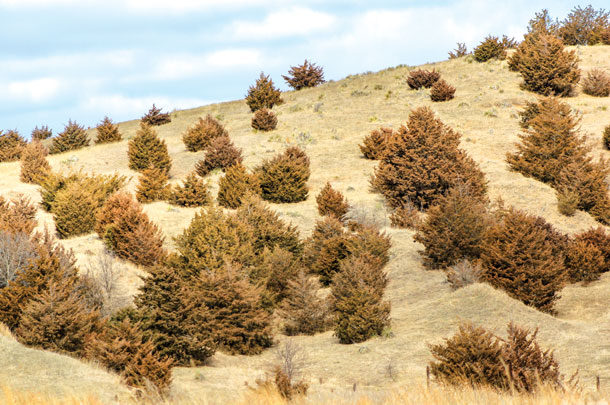Forage production on native grasslands is a vital component of Nebraska’s beef cattle industry, which had 1.9 million head of cows in 2018 (fourth in the U.S.). With land-use conversion from grasslands to croplands, and other management changes that have occurred over the last 150 years, native grasslands are often faced with a multitude of challenges.
One problem that has steadily increased is the encroachment of trees into grasslands. Eastern redcedar, a tree native to the Great Plains, has shifted a large number of acres from grassland into woodland.
Historically, eastern redcedar was found at relatively low frequencies in grassland systems, often only in areas with rougher topography. Because eastern redcedar is a non-sprouting species, frequent natural and human-set fires maintained areas as grasslands and limited tree encroachment.
Another factor that has caused an increase in eastern redcedar encroachment has been the extensive planting of this tree in windbreaks for livestock protection and conservation. Eastern redcedar has often been preferred in these plantings because of its rapid growth rate and adaptability to a wide range of climates and environments.
In Nebraska, millions of trees have been distributed and planted over the last century. These plantings, many of which are now over 30 years old, have created a large and well-dispersed seed source that has led to a large increase in eastern redcedar moving from windbreaks into adjacent grasslands.
Current grassland management practices on private lands over much of the Great Plains has been focused on forage production for beef cattle, and fire has largely been removed from these landscapes. The removal of frequent burning has allowed eastern redcedar to encroach into grasslands that typically would not have a frequent occurrence of these trees. Estimates suggest the eastern redcedar woodlands increased from about 54,000 acres in 1955 to over 330,000 acres in 2015. This encroachment continues to today at a high rate of spread.
Encroachment causes an ecological shift from a grassland ecosystem to an eastern redcedar woodland. Costs associated with this shift have been identified through much research in the Great Plains. The loss of forage from decreased grassland productivity is only one of many changes that occur with encroachment.
The Eastern Redcedar Science Literacy Project developed by Dirac Twidwell at the University of Nebraska – Lincoln highlights three areas of impacts caused by eastern redcedar encroachment: social costs, losses in biodiversity and productivity, and biophysical changes.
Social cost
- Increased taxpayer costs on federal, state and public school lands and producer costs on private lands to control cedars for grassland maintenance
- Reduced livestock production because of large losses in herbaceous biomass (Losses as high as 75% in heavily invaded areas)
- Increased wildfire risks and increased flames lengths in mature eastern redcedar woodlands often above what can be successfully suppressed by ground crews
- Potential reduction in stream flows
Losses in biodiversity and productivity
- Prairie chicken declines have been documented with less than 5% cover of eastern redcedar.
- Grassland-specific bird species replaced by woodland and/or shrub bird species
- Grassland species richness declines up to 88% in heavily encroached areas
- Herbaceous productivity declines of more than 70% when grasslands convert to closed-canopy woodland
- Reduced small mammal populations
Biophysical changes
- Shift of carbon storage from primarily underground with grasslands to primarily aboveground with eastern redcedar
- Soil moisture changes between grasslands and woodlands
- Increased soil pH of acidic soils because of the high calcium content in eastern redcedar litter
What can be done?
The spread of eastern redcedar has grown exponentially in highly invaded areas. Exponentially increasing eastern redcedar expansion highlights the large-scale threat this species imposes to grasslands in the Great Plains. As eastern redcedar encroaches into grasslands, it changes the ecosystem function of grasslands and limits grassland forage production potential for livestock production.
The sustainability of grasslands hinges on logical management of eastern redcedar at the individual landowner, landscape and state scales to address potential strategies that reduce the spread of this tree.
At the individual landowner scale, management of eastern redcedar should be a defined objective within the ranch or grassland management plan. Controlling eastern redcedar typically comes at a high cost in mechanical, chemical or fire treatments, but failure to control encroaching trees will often lead to larger losses.
To maintain grassland forage production, consistent, systematic monitoring and removal is important to staying ahead of encroaching trees. As with all invasive species, early detection and control provides the most efficient and successful opportunities to reduce invading species and maintain desirable species.
At the larger-landscape scale, collaborations among landowners, state and federal agencies, scientists and other stakeholders provide a framework for reducing the rate of spread over larger areas. A successful example of this type of collaboration is the Loess Canyons Rangeland Alliance in south-central Nebraska. In the last 15 to 20 years, this group has reclaimed nearly 60,000 acres of rangeland from eastern redcedar encroachment through collaborative action.
At the state scale, allocation of funding to support large collaborations for management of grassland ecosystems and input into solutions is vital to supporting the important values grasslands provide. Tree encroachment is a challenge that affects many different people in the Great Plains, and successful control of this tree will require a number of efforts at each of these management scales.
For more information on the impacts of eastern redcedar and potential management actions to maintain grassland ecosystem functions, visit the Eastern Redcedar Science Literacy Project . ![]()
PHOTO: Eastern redcedar has become a major problem in the Nebraska grasslands. Photo by Troy Walz.

-
Mitch Stephenson
- Range and Forage Specialist
- University of Nebraska – Lincoln
- Email Mitch Stephenson










